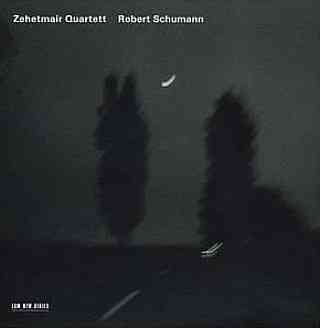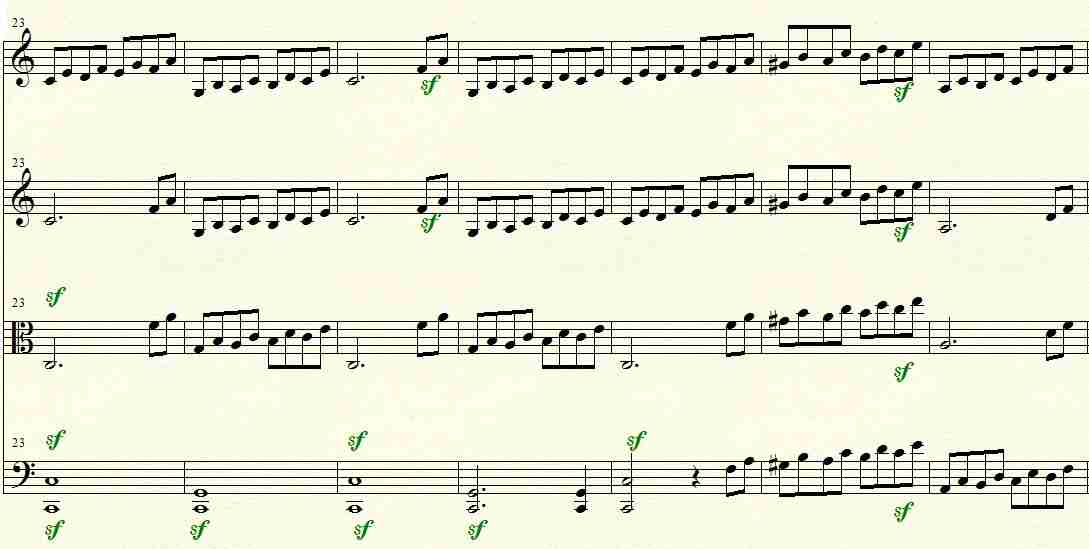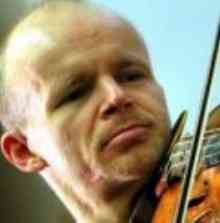
The Zehetmair String Quartet delivered an invigorating performance in Kansas City tonight.
- Mozart String Quartet in G Major, KV 156
- Hindemith String Quartet No. 4, Op. 22
- Schumann String Quartet No. 1 in A Minor, Op. 41
For entirely personal and idiosyncratic reasons, I found the Schumann Op. 41. No.1 quartet especially intriguing. There are passages in it that reminded me of a piece of software I had recently written, involving reflection and recursion in C# (.NET)—particularly the Quartet’s last movement, the Presto. My code is parallelized, to be run on a multi-CPU parallel multiprocessor in ‘sections’ that ‘rendezvous’ with each other to produce the final result. And so here I am, listening to the Zehetmairs, thrilled to notice sections of the Schumann quartet No. 1 with identical durations are treated as ‘privileged’—much in the manner that my software works—with the violins against the viola and ‘cello. The Zehetmairs’ orienting themselves physically on the stage as they did—in two parallel columns, with the cello directly facing the viola and the second violin directly facing the first violin—is what really ‘made’ the analogy to my code and how it works. As with so many compositions, there is a bias toward hierarchical and ‘nested’ structures in the piece. And there is the ‘repeat’—what programmers would call a loop or iteration. But there are also ‘reflection’ and ‘recursion’ in this quartet—phrases that invoke new instances of themselves, “passing in” new arguments whose values are set by what has gone before, and these invocations in turn invoke yet more instances/replicas. How cool!

Recursion, exemplified by calculation of N! (the factorial of a number, N) as you may remember from high-school maths, is a fundamental concept for expressing algorithms in computer science. Recursive algorithms are typically more elegant and have far more concise code than those whose flow-of-control is implemented in iterative and conditional loops. Recently K-nets and recursive structures have been receiving attention from mathematical musicologists and music theoreticians. But, as far as I’m aware, nobody up to now has looked at algorithmic recursion and reflection in Schumann’s compositions.

How did these quartets come to be? By way of history and background, in 1842 after Clara Schumann’s return home from her tour performing in Hamburg and Copenhagen, Robert composed furiously. This probably was one of the manic episodes of his bipolar disorder. He started in April and by the end of July he’d finished the three string quartets of his Opus 41. He was 32 years old.
It’s curious that Schumann, who’d never before composed a string quartet, would explode into the idiom with three all at once. It’s even odder that these quartets turned out to be his only chamber music works without piano. And why did he never return to this project? Why did he never write more string quartets?
This Op. 41 reflects Schumann’s rapid assimilation of technique and ideas from Bach’s ‘Well Tempered Klavier’. Over the course of the previous year he’d ‘inhaled’ the quartets by the Viennese composers; grasped their mechanics; understood their architecture and flow-of-control. He’d acquired the skills to be a “hacker” in a new idiom. The Quartet No. 1 is not emblematic of ‘borrowing’ as with Brahms and others but, instead, is emblematic of ‘acumen’.
In that regard, the thematic development and counterpoint in Quartet No.1, to me, bears the hallmarks of an eager “patch” contributed to a software open-source project by a ‘newbie’ who’s acquired a reasonable fluency by quietly ‘lurking’ in the project community for some months. Some of Schumann’s writing here is clearly pianistic. His usage is ‘opportunistic’, but it is not ad hoc. His style in this Quartet is ‘modest’ yet self-assured. Schumann is applying compositional techniques and gestures that he knows ‘work’, just as any [software] developer would do. He is generalizing design-patterns from his previous [software] projects. Yes, some of the writing is maybe technically awkward for the violins, as several violinist-writers have said over the years—the Scherzo maybe more so than the Presto. And maybe this alien, pianistic quality in fact conspires to create a certain hyperkinetic/kinesthetic ‘thrill’ for the violins—and for us listeners. It’s unsettling: that’s part of its meaning and charm, and undoubtedly as Schumann intended. This is the work of an adventurous developer, not some casual bricoleur.
So what? How would this resemblance, noticed only because of my own recent work in software development, shed any new light on Schumann or on this Quartet? I think it’s worth posting here because it illuminates a dimension of Schumann and his environment that may go beyond what regular biographers might have noticed. For example, any software developer does what he/she does “in community”, with the knowledge and anticipation that other developers will see and experience the code that he/she has written. So it is between composers—especially between a newbie writing her/his first composition in a particular genre and the community of established composers in that genre. And if my suggestion (that Schumann’s phrasing and pacing and compositional structures and technical fastidiousness resemble those of a modern-day software developer) has plausibility, then we should think about the “community” whose responses Schumann was anticipating. Yes, Schumann was writing these quartets in the shadow of Haydn and Mozart and Beethoven especially. And Boccherini, Cambini, Campagnola, Viotti, and Schubert, Hoffmeister, Spohr, Burgmüller, Kraus, Kramář, Gyrowetz, Hänsel, Rejcha, and Vranický, too. But maybe these quartets’ construction reflects an implicit anticipation of the reception by Mendelssohn, Chopin, Gossec, Vaňhal, Václav Pichl and Robert Volkmann and others.
Schumann in Op. 41 seems to be trying out some of the formal procedures of Beethoven’s late quartets—but with Schumann’s own original transformations. This Quartet No. 1 is no ‘homage’ as such. In fact, as Daniel Chua has suggested, maybe Schumann’s Op. 41 was conceived in somewhat the way that Beethoven’s Op. 127 was conceived—as a means to influence musical history, rather than to reflect the musical past. These Op. 41 quartets are advancing new methods of theme construction, movement structure, and quartet orchestration. Here we have Schumann (maybe like Beethoven before him) preferring, socially, to be the musical ‘hammer’ rather than the ‘anvil’.
And so it is as well with open-source software developers. Self-styled hammers they are, never content to be anvils!

More than anything, and knowing as we do that this was Schumann’s first string quartet, what we hear are “transgressive” gestures of a “newbie” to string quartet writing. As a software developer myself, I see evidence in Op. 41 that’s reminiscent of an intense young software developer, one who is new to a particular tool-set and new project architecture / design patterns. To me, this is Schumann bursting in upon the composerly society of quartet writing, much in the manner of a developer making her/his first contribution to an open-source collaboration, such as SourceForge.
R ule 1: Stick to your level of Karma. Open-source is not a democracy. You have heard something different? This is wrong. Always keep in mind: Open-source is not a democracy. Every developer has a certain unexpressed and inexpressable level of Karma, which allows him/her to decide (or even dictate) things and to make use of the infrastructure of the community (like their version control system, their servers, etc.). Think of Karma like your “points level” in a role-playing computer game. The more levels you’ve played and the more riddles you’ve solved, the higher your Karma level grows. But beware: your Karma may be damaged or lost, if you act improperly. If you are new to a community, your Karma level is zero by default. Always keep that in mind. What is Karma? Karma basically means the trust the community has in you. It is not possible to measure Karma or even to guess it. If you have to ask, you’ll never know.”
— Tobias Schlitt, 10 Golden Rules for Open-Source, 19-APR-2007
After this No. 1 fugato Andante espressivo opens in A minor, we get what sounds like a second theme in the relative major. But this turns out in fact to be a first theme: the A-minor section was just a slow introduction. The movement never returns to A minor but instead finishes in F major.
The Adagio is basically a Lied in F major, and the F major evokes further uncertainty about the quartet’s tonal center. The scherzo movement is a normal, ternary form with a contrasting Intermezzo.

The vigorous Presto in A minor closes the quartet. This is the movement that immediately reminded me of my application in C# (.NET).

Schumann iterates a rising-fifth motive. He sets up so-called Kreutzer exercise figurations (Rodolphe Kreutzer’s violin etudes, designed to strengthen the violinist’s left hand) that are not just repetitive iterations but recursive—each successive instance appears to invoke yet more instantiations of the figure, in a cascade inward. The cascades alternate between the violins and the viola and ‘cello. Programmerly recursion! Not whole phrases, but smaller-scale movements within the phrases.

[ 60-sec clip, Zehetmair Quartet, Schumann Op. 41, No 1, Presto, 2MB MP3]
Have a look at Scott Murphy’s recent article in Music Theory Online, to read a discussion of recursive regimes, Klumpenhouwer Networks, and other mathematical structure in Bartók and other classical music composers’ work. Have a look at Roger Reynolds’ book ‘Form & Method’ for more.
What about Schumann’s personality? How might that have affected what we hear in these quartets?
Provided that extensive rework doesn’t plaster over the original features, isn’t a person’s exploration of writing in a genre that is unfamiliar likeliest to reveal the inner life of that person? I suspect the answer is yes. After all, aren’t ‘first novels’ inherently first-novel-esque?
So. If we’re going to indulge in speculation about Schumann, let’s not omit his well-documented bipolar disorder. Bipolar disorder, also known as manic-depressive illness, only affects about 1% of the general population. But the prevalence rises to 30% among authors, artists, and composers—Schumann among them. Johns Hopkins professor Kay Redfield Jamison’s wonderful book ‘Touched with Fire’ looks at bipolar disorder and artists, authors, and composers. By contrast, there’s a conspicuous lack of studies of the prevalence of bipolar disorder in other creative professions, such as science, engineering, and especially software engineering.
Anybody who’s a software developer and a musician has plenty of anecdotal evidence, though. Earning a living as a software developer requires feats of memory and comprehensive recollection of protean details (of syntax of dozens or hundreds of compiler, version-control, and other software development toolsets and operating systems) that are very similar to the occupational requirements for mastery and internalization of detail such as professional musicians have. This often isn’t understood by lay persons who aren’t software engineers. But it is a commonplace, to anyone involved with software or anyone whose friends or family members are engaged in these pursuits.
It’s especially so for individuals who create open-source software—who invest hundreds of hours each year doing so, for zero financial reward. Their intellectual ‘giftedness’ is what propels them to deposit the fruits of their labors into the public domain. They do not, in general, do what they do for ulterior reasons. They are, in general, aiming to create functional, beautiful things. The process of creating, the process of innovating and moving the ‘community’ forward, are sufficient internal rewards by themselves. And, for some, their Karma, here and now, is a more reasonable concept than conventional religion.
According to Karma, performing beneficent acts brings good luck, and negative or maleficent acts result in bad luck. The consequences may arise immediately or they may be delayed. For Hindus and others, the delay can be in the present life or in the next: morally commendable acts may result in reincarnation into a higher station or class (such as a superior human or a godlike being), while bad acts result in rebirth as a human living in less desirable circumstances, or as a lower animal. Some compare the action of Karma to Western notions of sin and judgment by God or gods. Other non-deistic people understand Karma as a principle of the universe—a natural law that doesn’t require the existence or intervention of any supernatural Being.
The logical ethical consequence of the law of Karma is to behave responsibly at all times and not abuse the power that comes with virtuosity. Thomas Zehetmair and the Zehetmair Quartet are clearly creating and maintaining their good Karma. And Schumann, in his own way, may have composed these quartets—replete with fascinating recursive structures and other innovations—with the Karmic and social sensibilities that, today, are prevalent among open-source software developers as well as musicians. Just a thought.

[Sorry if you were hoping to find here an actual ‘review’ of the Zehetmair String Quartet’s performance in Kansas City. Suffice to say that their playing was, has been, and shall be spectacular. They are performing today (11-NOV) at the University of California @ Berkeley, and on 16-NOV in the ‘Music_at_MIT’ program in Cambridge, MA. In any case, go and hear them whenever and wherever you can! Buy their CDs and listen! Surely the depth and vibrancy of their interpretations will inspire unusual reveries/epiphanies as personally meaningful for you as the ones they stimulated in me. Possibly also of interest, besides Thomas Zehetmair’s commitment to this Quartet and to the classical violin repertoire, he dedicates a large part of his artistic activities to contemporary music. He’s given a number of first performances, such as the violin concerto written for him by Heinz Holliger and the violin concertos of James Dillon and Hans-Jürgen von Bose. His latest CD releases include the Ysaye Sonatas for solo violin, the Holliger Violin Concerto with the SWR Sinfonie-Orchester, and the Beethoven Triple Concerto with the Chamber Orchestra of Europe. Excellent, each and every one.]
- Zehetmair Quartet at Mariedi Anders Management
- Thomas Zehetmair at Askonas Holt Agency
- Zehetmair at ECM
- Reflection comp sci page on Wikipedia
- SourceForge.net
- Anglada T. Intense Minds: Through the Eyes of Young People with Bipolar Disorder. Trafford, 2006.
- Aubry J-M, Ferrero F, Schaad N, Bauer M. Pharmacotherapy of Bipolar Disorders. Wiley, 2007.
- Beaver G. The PEAR Installer. Packt, 2006. (Greg is cellist of Chiara string Quartet. His other gig is writing open-source software, managing software development projects, and writing books like this one.)
- Blum D. The Art of Quartet Playing: The Guarneri Quartet in Conversation with David Blum. Knopf, 1987.
- Burgin M. Super-Recursive Algorithms. Springer, 2004.
- Burkholder J, Giger A, Cox F, Birchler D, eds. Musical Borrowing: An Annotated Bibliography. Indiana Univ, 2003.
- Chopra S, Dexter S. Decoding Liberation: The Promise of Free and Open Source Software. Routledge, 2007.
- Chua D. The Galitzin Quartets of Beethoven (Opp. 127, 130, 132). Princeton Univ, 1995.
- Daverio J. Robert Schumann: Herald of a New Poetic Age. Oxford Univ, 1997.
- Deek F, McHugh J. Open Source: Technology and Policy. Cambridge Univ, 2007.
- Eisler E. 21st-Century String Quartets. String Letter, 2000.
- Feller J, Fitzgerald B, Hissam S, Lakhani K, eds. Perspectives on Free and Open Source Software. MIT, 2007.
- Geller B, Delbello M, eds. Bipolar Disorder in Childhood and Early Adolescence. Guilford, 2003.
- Goodwin F, Jamison K. Manic-Depressive Illness: Bipolar Disorders and Recurrent Depression. 2e. Oxford Univ, 2007.
- Griffiths P. The String Quartet: A History. Thames and Hudson, 1983.
- Hatten R. The Place of Intertextuality in Music Studies. American Journal of Semiotics 1985; 3/4: 69-82.
- Jamison K. Touched with Fire: Manic-Depressive Illness and the Artistic Temperament. Free Press, 1996.
- Jensen E. Schumann. Oxford Univ, 2001.
- Lorentz R. Recursive Algorithms. Ablex, 1994.
- Mannheimer Streichquartett. Volkmann: String Quartets 1 & 4. (CPO, 1994.)
- Mannheimer Streichquartett. Volkmann: String Quartets 2 & 5. (CPO, 1994.)
- Mannheimer Streichquartett. Volkmann: String Quartets 3 & 6. (CPO, 1994.)
- Meeker H. The Open Source Alternative: Understanding Risks and Leveraging Opportunities. Wiley, 2008.
- Miklowitz D. The Bipolar Disorder Survival Guide: What You and Your Family Need to Know. Guilford, 2002.
- Murphy S. Considering Network Recursion and Bartók’s Fourths. MTO 2007; 13(3)
- Ostwald P. Schumann. Northeastern Univ, 1987.
- Parker M. String Quartets. Routledge, 2003.
- Pilato C, Collins-Sussman-B, Fitzpatrick B. Version Control with Subversion: Next Generation Open Source Version Control. O'Reilly, 2008.
- Raymond E. The Cathedral & the Bazaar: Musings on Linux and Open Source by an Accidental Revolutionary. O'Reilly, 2001.
- Reynolds R. Form and Method: Composing Music: The Rothschild Essays. Routledge, 2007.
- Rounds D. The Four & the One: In Praise of String Quartets. Lost Coast, 1999.
- Schumann R. Letters of Robert Schumann. Library Reprints, 2001.
- Scott H. Indebtedness in Music. The Musical Quarterly 1927; 13: 497-509.
- Shapira N, Goldsmith T. Psychiatric Features of Individuals With Problematic Internet Use. Journal of Affective Disorders 2000; 57: 267-72.
- Soderberg J. Hacking Capitalism: The Free and Open Source Software Movement. Routledge, 2007.
- Steinhardt A. Indivisible by Four. Farrar, Straus Giroux, 2000.
- Still B, Amant K, eds. Handbook of Research on Open Source Software: Technological, Economic, and Social Perspectives. IGI, 2007.
- Stowell R, ed. The Cambridge Companion to the String Quartet. Cambridge Univ, 2003.
- Todd R, ed. Schumann and His World. Princeton Univ, 1994.
- Williams M. Microsoft Visual C# .NET. Microsoft, 2002.
- Woods D, Guliani G. Open Source for the Enterprise: Managing Risks, Reaping Rewards. O'Reilly, 2005.
- Worthen J. Robert Schumann: Life and Death of a Musician. Yale Univ, 2007.
- ArtOfTheStates.org string quartet page
- Sandow G. Four-Piece Orchestra, 1995.
- Op. 41 No. 1 score in Coda Finale / Music XML at ProjectGutenberg
- PatientsLikeMe.com
- FasterCures.org
- Institute for Pediatric Innovation.org
- ScienceCommons.org
- CreativeCommons.org
A man can know no greater torment than to look forward to a lifeless future of his own planning.”
— Robert Schumann
V ery often what we look for in the distance is so near that we need only stretch out our hand to seize it.”
— Robert Schumann

No comments:
Post a Comment